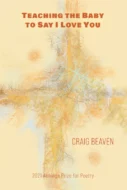 Craig Beaven
Craig Beaven
Teaching the Baby to Say I Love You
Anhinga Press
Reviewer: David E. Poston
Teaching the Baby to Say I Love You is informed by Craig Beaven’s perspective as a parent and teacher, responsible for his own young children, still in the prelapsarian world, and for his students, on the cusp of leaving it. Beaven begins with hard questions about the dangers from which we cannot shield our children. His perspective broadens to examine questions of individual, cultural, and historical identity. Grounded in lived experiences and awareness of the power of words and symbols, this collection contrasts the innocence of children with the flawed and fraught world they will inherit.
The fourteen-part title poem is a fugue on gun violence, language, love, innocence and experience, the body, and the weight of history. It is held together by repeated phrases and images that build on each other and are echoed in the two later sections. The third section may seem oddly tacked-on at first, fixated on memorials to Jefferson Davis spread across the south, but as one continues to read, echoes of the motifs that energize the title poem emerge to tie it to the central themes of the book.
The title poem begins: “How many gun deaths / today, by the end of today?” The existential fear raised by that question pervades the poem and later ones such as “Active Shooter Ghazal.” Today, just an ordinary day, a student named Brady starts a joke with “last night at the mall we were walking in and these two Black guys ….” He does not finish it, though, when he remembers Beaven’s children, two Black children adopted by a white father. Brady is becoming aware of the power of words to cause hurt as well as amusement.
The joke that Brady starts becomes
another hash mark
on the line of human history. This
is the oppressor’s language: we say
I love you
and the baby just laughs.
Beaven would like to leave Brady and his classmates in the whirl of the Sadie Hawkins dance, to leave his daughter as a baby, to remain in the moment when his two-year-old son asks, “I love the cat, does the cat love me?”
By the end of the poem, the full scope of what Beaven is addressing emerges. He worries about his young children’s exposure to language: not the language of Run the Jewels, but the language of the oppressor. His students don’t know life or history or their own bodies. He interposes observation of his infant daughter becoming aware of her body with the memory of a poster he observed on his own fourth-grade classroom wall, one that gave him “a postlapsarian glimpse” of what he would become. He intertwines memories of choosing Tessa’s name with recounting how his school yearbook banned rap song lyrics but allowed Robert E Lee quotes.
As the adolescent psychology book says, “teenagers hate everything because they are afraid.” The ninth part of the title poem describes how adults are just as fearful, when neighborhood rumors of a black man with a gun spark unfounded terror. When students want to protest against school shootings, his school administration is concerned that a protest will alienate parents who are NRA members. A mean-spirited friend’s hateful comment about Muhammad Ali’s death recalls for Beaven how even The New York Times refused for years to accept Ali’s name change. That same mean spirit is echoed later in “Attempts at Rescue,” where a zero-sum mentality leads to lack of compassion for overdose victims.
In the book’s middle section, “Virtu” examines the history of the emblem on the school uniform:
the helmet the Spanish wore
as they slashed
then marched
through the new world
of north Florida,
and believed in gold,
and went crazy—
The emblem of the oppressor is now perversely abstracted into a symbol of the pursuit of knowledge. “Portrait of My Daughter in Repose” responds poignantly to the murder of Breonna Taylor:
She’s five years old,
my daughter, so when will I tell her
about Breonna Taylor? What if they didn’t
always carry guns, hmmm, that’s a good
idea. I wonder if she is shielded by me, a white father?
If she were white you couldn’t kill her.
The concluding section, “War on Terror Memorial Highway,” covers a geography haunted by its Confederate past, stretching from Dallas to Stone Mountain to Panama City. Its opening poem, “At Only Four Days Old My Son Was Called the N-Word,” reprises earlier themes: the terrible weight of words, the burden of history, the existential terror of gun violence.
This section introduces a series of memorials to Jefferson Davis as a symbol of the power of words to distort or to challenge history. This is a landscape where Nephila clavipes is called the Jefferson Davis spider, where star jasmine is called Confederate jasmine, where an image of Ray Charles is projected onto the face of Jefferson Davis carved in Stone Mountain. The challenge to this distorted legacy is illustrated in poems such as “Pioneer Cemetery, Dallas, Texas,” which describes a palimpsest of graffiti on a Jefferson Davis memorial:
Across the plaque describing valor
and bravery, someone has written
you fought for the wrong side.
The section’s title poem continues to weave the threads of identity, geography, and history. It describes terrors that are sometimes explicit—“Go to church or the devil will get you”—and sometimes more implicit:
Confederate Memorial Park is fear
of the years, of the earth’s
revolutions stacking days against
the past.
“Inscriptions on a Jefferson Davis Monument Never Built But Maybe One Day I Will” continues the collection’s major themes. The section titled “North Facing Side” describes how a businessman asks the speaker how a white guy ended up with a beautiful Black son,
but smiles kind to let me
in on the joke, the setup
of a vaudeville
routine never performed
but I don’t know
my line …
“East Facing Side: Stand Your Ground” addresses the knee-jerk neighborhood racism described in the title poem, with the speaker instructing his Black son to
Never forget: Never walk
up to the porch
to pet a cat. If a ball
goes into anyone’s yard,
even if they are our friends, do not,
do not retrieve a frisbee,
come and get me and I
will go for you,
because I am white,
they will not kill me.
The final poem, “Coda: Panama City Beach, Florida,” sums up the toxic legacy pervading this landscape:
… The country
of the flag is gone, gone one hundred
and fifty years, but do they long.
How do we teach our children to feel and express love in a world clinging to madness? How does a teacher avoid perpetrating the language of the oppressor, or a parent keep from passing on the burdens of the past? Beaven’s title poem ends with these lines to his daughter, conveying the core of his answer:
Tessa—the way our bodies
are always dying, the world
has always been ending,
and despite this
we are born there, we live
inside it, it is the only world
where I can reach you.
By custom it’s called
America, and by our place
in the universe
it’s called
the present, I’m giving you
the only
language I can. Every single day
we grow a little bit older
and as we grow
our love grows.
At the end we’ll have
so much love…
We will feel…I don’t know what it means
to feel, where in our body it lives,
but by custom I say
we feel it, and we will be so full
of this joy called love
I believe
It will have all been worth it.

